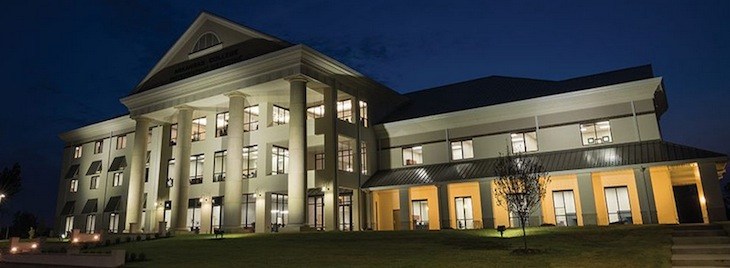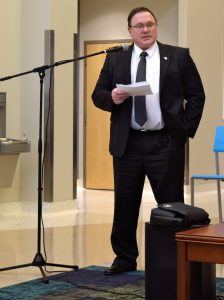ARCOM human donor program gives medical students a chance to work with their ‘first patients’
by July 10, 2018 4:07 pm 2,472 views

Dr. David McWhorter, professor and chair of anatomy at the Arkansas College of Osteopathic Medicine (ARCOM), has spent more than 20 years in the medical profession. As an anatomist, one of his major goals is to acclimate young medical students to the anatomical donors, who offer their bodies to science when they die.
McWhorter leads first-year students through six hours of weekly labs in addition to lecture time each week of the fall semester at the Fort Smith-based college. His class is required, and for many of the 150 students going through it, working on an actual human “donor” is their first “rite of passage” to become doctors.
“We start out on day one and introduce the students to their donors, and we do this in a very thoughtful way because this is the first time these young people have been exposed so close up to death,” McWhorter told Talk Business & Politics in a recent interview. “I go through a brief introduction as to the privilege it is for them to have this opportunity to study a human, and for them to know this was somebody’s child, somebody’s daughter, somebody’s son, possibly somebody’s mother, father, brother, sister, uncle, aunt, and so on. And I tell them, we will operate with the utmost respect.”
The message is well-received. McWhorter knows at this stage of his students’ educational career, they realize the magnitude.
“There is a mixture of emotions that range from excitement to fear, and that’s why we take everything very slow. That’s why we have stools at every table, and I tell them, ‘If this is starting to bother you, then, by all means, take a seat.’ But there is a sense of excitement because most medical students know the study of anatomy is a real part of becoming a future physician, and they know this is a rite of passage, and most of them handle it very well. Some students, it takes them a little longer to acclimate, but I’ve had very few in my 20-plus career who don’t acclimate.”
Some of the students who come in have experienced comparative anatomy classes — working on cats, rats, sharks — “but coming in and studying a real human is a lot different,” McWhorter said. To further help the adjustment phase, donors are kept covered through much of the study so each group of four students can only view the portion of the body they’re assigned. McWhorter starts his students on the donor’s back. This has two purposes.
“One, it’s a little less personal to start on the back. And the second reason is the back tends to have structures that students can dissect with minimal skill. The psychomotor skills are very minimal in terms of this so it’s a good place to start from a skill set and a psychological perspective.”

As students near the end of the course, the inverse is true.
“The face is the last region we cover, and again, that’s on purpose because one, the face is the most personal, and two, the head and neck are the most complex regions of the human body based on the number of structures that are in a very small area. By then, the students have acquired sufficient skill to dissect these things that are on the verge of being microscopic. We will look at things as small as the tip of a paper clip in the orbit of the eye that is important in terms of the function of the eye.”
Even as a veteran anatomist, McWhorter calls the architecture of the human body “amazing” and “miraculously put together,” adding the students “get the opportunity to appreciate firsthand the awe of the creation of the human body” in a way that just isn’t possible through computer models and high-tech equipment. “It’s that three-dimensionality. The topography of how one structure relates to another. You just can’t mimic that with a machine.”
COMMUNITY SUPPORT
While McWhorter’s training process runs like a well-oiled machine, his experience at ARCOM has been quite different. That’s because until he arrived in Fort Smith, he’d never built a human donor program from the ground up. The other positions he held — in Kansas City, Atlanta, Augusta, Ga., Spartanburg, S.C., Hattiesburg, Miss. — were at institutions that received donors from other facilities. (And “donors” is the acceptable term, McWhorter notes, because “these people have selflessly given their bodies for our students’ education.”)
When he started with ARCOM in 2016, the program didn’t exist. And to his surprise, Fort Smith residents embracing their new university were asking for it.
“We moved into the building, and it was the year before the students arrived. And a number of community members asked me, ‘How can I donate my body to science?’ I also had a number of calls asking the same thing. … I have been a faculty member at multiple schools throughout my career, but I have never seen this level of support from a community. I felt a moral obligation to investigate the possibility to see if we could do this.”
McWhorter took the idea to Kyle Parker — president and CEO of the Arkansas Colleges of Health Education (ACHE), ARCOM’s parent — and together they worked through the legalities. The first donor arrived in “early 2017” — McWhorter couldn’t remember the exact date, but there were 10 by the first day of school. Since then, the number has risen to 25 with a total capacity of 40.
Storage of the donors comes with a unique set of challenges — namely transport, preparation (“embalming”), and cremation once the study is finished. Donor preparation is different from prep for a traditional funeral. Fluids transferred into the body are designed to ensure use for over a year and a half, while funeral prep uses a lower percentage of chemicals to ensure a more natural look for family viewing. The “year-and-a-half” need is to guarantee there are enough donors for incoming students on day one. As McWhorter explains, a donor received in September 2018 wouldn’t be available until the following fall semester, and he or she would need to remain available until the end of 2019.
A CEREMONIAL END
After the study is complete, donors are cremated at no expense to the family and honored in a non-denominational spring ceremony. ARCOM held its first on Feb. 15 in the Kyle Parker Atrium on the first floor of the ARCOM building. Only students, faculty, administration, and family members were invited to attend.
“We had a couple of donors’ families who showed up, but not all families want to go and pay respect because there are a lot of different family dynamics out there,” McWhorter said.
Nevertheless, the memorial service is a chance to honor the donors, their families, “as well as give closure to our students.”
“While the students are given very little information — age and, if known, the cause of death — they get to intimately know these donors, and they form their own stories and connections,” McWhorter said.
On June 28, ACHE announced it had secured a $500,000 grant from The Degen Foundation to build a “celebration garden and wellness park” as a lasting memorial to their current and future donors — the people, McWhorter said, who are his students’ “first patients.”
